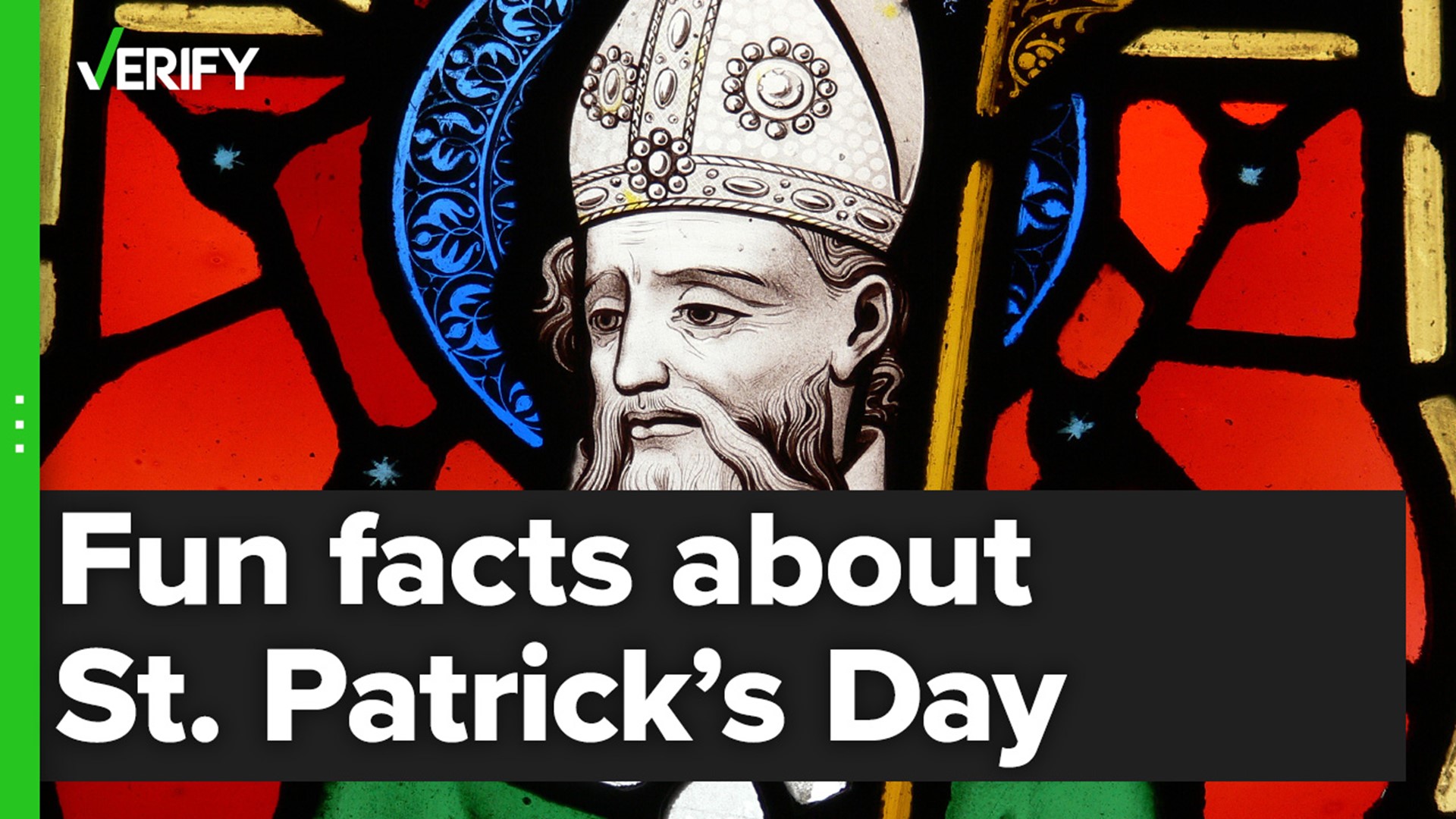The celebration of Irish heritage known as St. Patrick’s Day falls on March 17 every year. The holiday honors Saint Patrick, the patron saint of Ireland who is known for bringing Christianity to the country over 1,000 years ago.
St. Patrick’s Day is typically associated with the color green, shamrocks, parades and drinking pints of Irish beer at the pub. But there are plenty of interesting facts about the holiday that many people may not know. The VERIFY team answers questions about St. Patrick’s Day.
THE QUESTION
Was blue the first color associated with St. Patrick’s Day?
THE SOURCES
- National Museum of Ireland
- Elizabeth Stack, Ph.D., executive director of the Irish American Heritage Museum in Albany, New York
- James Deutsch, Ph.D., curator at the Smithsonian’s Center for Folklife and Cultural Heritage
THE ANSWER
Yes, blue was the first color associated with St. Patrick’s Day.
WHAT WE FOUND
While green is the color most people today associate with St. Patrick’s Day, the color blue was the original color of the holiday, according to Elizabeth Stack, Ph.D., the executive director of the Irish American Heritage Museum in Albany, New York, and James Deutsch, Ph.D., a curator at the Smithsonian’s Center for Folklife and Cultural Heritage. In fact, a National Museum of Ireland spokesperson told VERIFY that the color blue is considered the official color of Ireland.
So where did green come from?
“After the Irish Rebellion in 1798, the Irish soldiers differentiated themselves from the British (who are wearing red clothing) by wearing full green uniforms. The shamrock on their hats was a symbol of rebellion,” Deutsch told VERIFY in an email.
THE QUESTION
Was Saint Patrick originally from Ireland?
THE SOURCES
- National Museum of Ireland
- Royal Irish Academy
- Philip Freeman, Ph.D., author and professor of humanities at Pepperdine University’s Seaver College
THE ANSWER
No, Saint Patrick was not originally from Ireland.
WHAT WE FOUND
Saint Patrick was born around the year 390 to an aristocratic family in the Roman province of Britain, Philip Freeman, Ph.D., an author and professor of humanities at Pepperdine University’s Seaver College, wrote in the book “St. Patrick of Ireland: A Biography.” Freeman said St. Patrick was captured around the age of 15 by Irish pirates who took him to Ireland.
After experiencing six years of slavery in Ireland, St. Patrick escaped and fled back to Britain where he eventually reunited with his family. He later returned to Ireland as a Christian missionary, where he became the patron saint and national apostle of Ireland.
A National Museum of Ireland spokesperson also told VERIFY that St. Patrick was not originally from Ireland.
“He came from Britain, possibly from a place called Bannaventa Berniae or Banna Venta Berniae. Its exact location is not known, but some researchers suggest it is in, or close to, Wales,” the museum spokesperson explained.
There are two surviving works by St. Patrick that give invaluable detail on his life and the early church in Ireland, according to the museum spokesperson. The first is his “Confessio,” in which he provides details on who he is, where he came from, who his father was, and his life in Ireland. The second is his “Letter to the soldiers of Coroticus,” in which he details the treatment of Christians in Ireland at the time.
THE QUESTION
Is the shamrock the national plant of Ireland?
THE SOURCES
- Ireland’s Department of Enterprise, Trade and Employment
- National Museum of Ireland
- James Deutsch, Ph.D., curator at the Smithsonian’s Center for Folklife and Cultural Heritage
THE ANSWER
Yes, the shamrock is the national plant of Ireland.
WHAT WE FOUND
The shamrock is the national plant of Ireland, and it’s one of the most famous symbols of St. Patrick’s Day, according to the National Museum of Ireland. The word “shamrock” comes from the Irish word “seamróg,” which translates to “little clover.”
The National Museum of Ireland says there is a widely held belief that St. Patrick used the shamrock to explain the Holy Trinity, which is the Christian concept of God as three entities: the Father, the Son, and the Holy Spirit. But the museum explains on its website that it is “unlikely that the Irish needed explanation of the concept of three persons in one, as triads were central to pre-Christian Celtic religious tradition.”
Ireland’s Department of Enterprise, Trade and Employment and the National Museum of Ireland says the first record of the shamrock being used as a badge on St. Patrick's Day dates back to the 17th century. In 1681, Thomas Dinely, an Englishman traveling through Ireland, noted that people of all distinctions wore crosses to commemorate the saint on St. Patrick’s Day, “but noted that only the vulgar, as he called them, wore shamrock.”
In current times, the shamrock is used extensively as a badge by Irish sports teams and as a component of the logos of some Irish organizations and companies, according to the Department of Enterprise. The shamrock is also displayed on the uniforms of Irish troops serving abroad.
THE QUESTION
Did St. Patrick banish snakes from Ireland?
THE SOURCES
- National Museum of Ireland
- Philip Freeman, Ph.D., author and professor of humanities at Pepperdine University’s Seaver College
THE ANSWER
No, St. Patrick did not banish snakes from Ireland.
WHAT WE FOUND
There’s a legend in Ireland that St. Patrick banned snakes from the country, but it’s false, according to a National Museum of Ireland spokesperson. This is because there were never any snakes in Ireland to begin with, author Philip Freeman wrote in his book “St. Patrick of Ireland: A Biography.”
“Snakes are not native to that country,” Freeman said. “This story was made up centuries later by well-meaning monks.”
The National Museum of Ireland spokesperson told VERIFY that when the last ice age ended, plants and animals began to recolonize Ireland. However, when the ice melted, the sea levels rose, cutting off Ireland from Britain and the rest of Europe.
“Many species, which are found in Britain and the rest of Europe, never made it to Ireland,” the spokesperson explained. “To this day we have a much more restricted variety of species in Ireland than even in our nearest neighbors in Britain. So while there are a small number of snake species in Britain, there are none in Ireland.”












